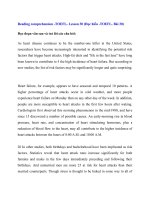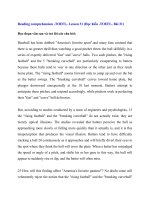Tài liệu Đọc hiểu -TOEFL- Bài 30 docx
Bạn đang xem bản rút gọn của tài liệu. Xem và tải ngay bản đầy đủ của tài liệu tại đây (76.33 KB, 5 trang )
Reading comprehension -TOEFL- Lesson 30 (Đọc hiểu -TOEFL- Bài 30)
Đọc đoạn văn sau và trả lời các câu hỏi:
As heart disease continues to be the number-one killer in the United States,
researchers have become increasingly interested in identifying the potential risk
factors that trigger heart attacks. High-fat diets and "life in the fast lane" have long
been known to contribute to 5 the high incidence of heart failure. But according to
new studies, the list of risk factors may be significantly longer and quite surprising.
Heart failure, for example, appears to have seasonal and temporal 10 patterns. A
higher percentage of heart attacks occur in cold weather, and more people
experience heart failure on Monday than on any other day of the week. In addition,
people are more susceptible to heart attacks in the first few hours after waking.
Cardiologists first observed this morning phenomenon in the mid-1980, and have
since 15 discovered a number of possible causes. An early-morning rise in blood
pressure, heart rate, and concentration of heart stimulating hormones, plus a
reduction of blood flow to the heart, may all contribute to the higher incidence of
heart attacks between the hours of 8:00 A.M. and 10:00 A.M.
20 In other studies, both birthdays and bachelorhood have been implicated as risk
factors. Statistics reveal that heart attack rates increase significantly for both
females and males in the few days immediately preceding and following their
birthdays. And unmarried men are more 25 at risk for heart attacks than their
married counterparts. Though stress is thought to be linked in some way to all of
the aforementioned risk factors, intense research continues in the hope of further
comprehending why and how heart failure is triggered.
1. What does the passage mainly discuss?
(A) risk factors in heart attacks
(B) seasonal and temporal patterns of heart attacks
(C) cardiology in the 1980s
(D) diet and stress as factors in heart attacks
2. In line 3, the word "potential" could best be re-placed by which of the
following?
(A) harmful
(B) primary
A
D
(C) unknown
(D) possible
3. The word "trigger" as used in line 3 is closest in meaning to which of the
following?
(A) involve
(B) affect
(C) cause
(D) encounter
4. Which of the following could best replace the word "incidence" as used in
line 5?
(A) increase
C
B
(B) rate
(C) chance
(D) factor
5. The author uses the word "temporal" in line 9 to mean
(A) affected by
(B) of a certain date
(C) expected
(D) regularly
6. The phrase "susceptible to" in line 12 could best be replaced by
(A) aware of
A
D
(B) affected by
(C) accustomed
(D) prone to
7. According to the passage, which of the following is NOT a possible cause of
many heart attacks?
(A) decreased blood flow to the heart
(B) increased blood pressure
(C) lower heart rate
(D) increase in hormones
8. The word "phenomenon" in line 14 refers to which of the following?
(A) habit
C
C
(B) illness
(C) occurrence
(D) activity
9. The word "implicated" in line 21 could best be replaced by which of the
following?
(A) indicated
(B) disregarded
(C) investigated
(D) discovered
10. Which of the following is NOT cited as a possible risk factor?
(A) having a birthday
A
B
(B) getting married
(C) eating fatty foods
(D) being under stress
11. Which of the following does the passage infer?
(A) We now fully understand how risk factors trigger heart attacks.
(B) We recently began to study how risk factors trigger heart attacks.
(C) We have not identified many risk factors associated with heart attacks.
(D) We do not fully understand how risk factors trigger heart attacks.
12. As used in line 22, which of the following could best replace the word
"reveal"?
(A) show
D
A
(B) observe
(C) mean
(D) explain









